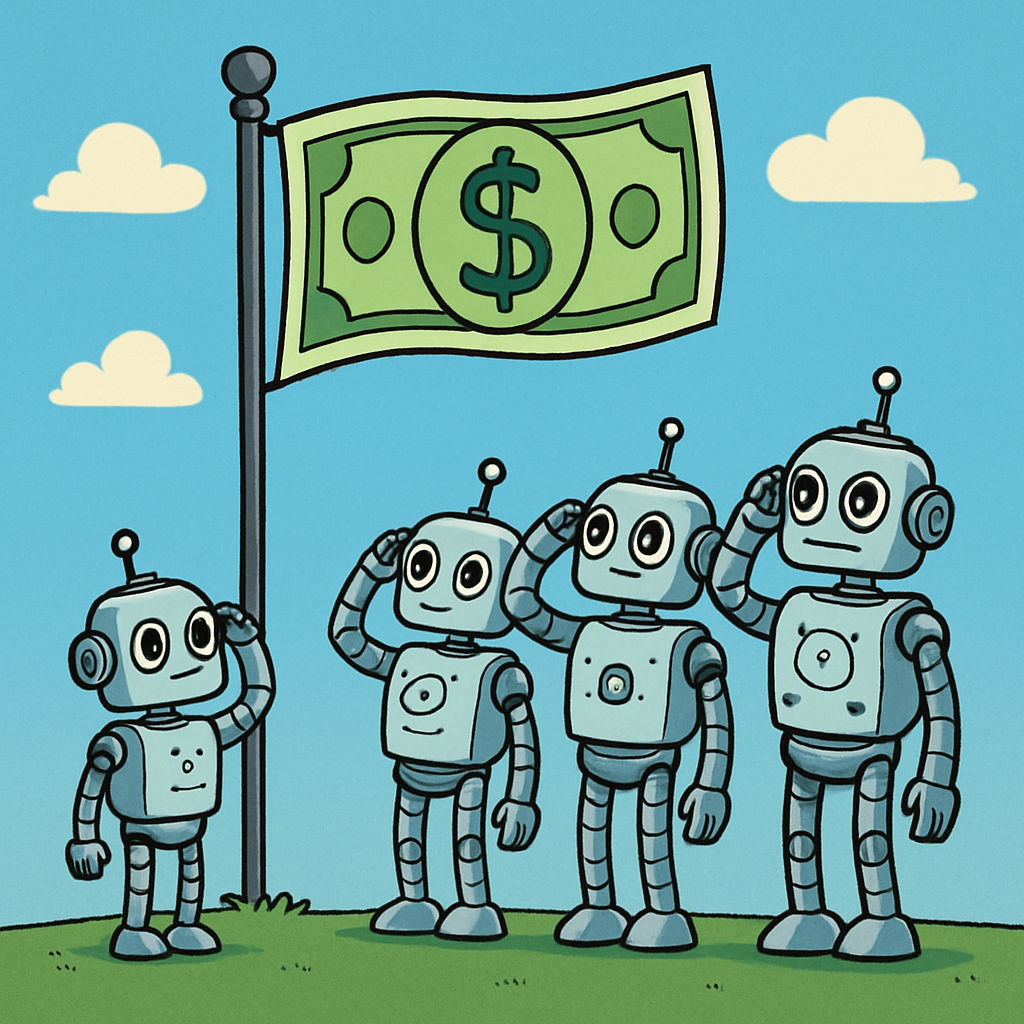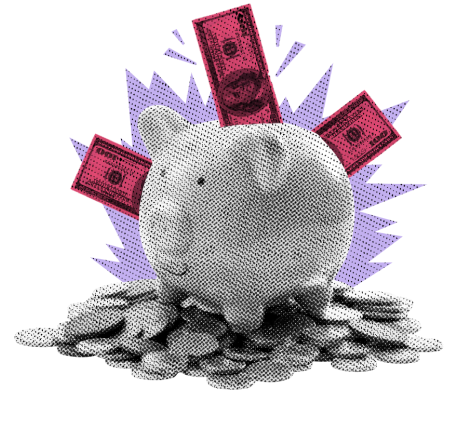
De-dollarization is a myth. The world still runs on U.S. trust, markets, and innovation–not gold bars.
KEY TAKEAWAYS
-
Gold’s rise is being driven by sovereigns, not retail investors
-
The U.S. dollar’s dominance rests on innovation, liquidity, and military strength
-
America’s open, risk-rewarding capitalism fuels global trust
-
Gold can’t replace what the dollar represents: credibility
-
De-dollarization fears ignore the system that sustains the dollar’s power
MY HOT TAKES
-
Gold is offense disguised as defense
-
The dollar is backed by innovation–not ideology
-
Liquidity and trust are the real global currencies
-
You can’t “buy” credibility–you have to earn it
-
America’s chaos is its competitive advantage!
-
You can quote me: “When you hold dollars, you’re holding a share in the world’s most innovative company: the United States.”
Innovation standard. As I sip my way through espresso number two each morning, you could find me sitting–mostly in the dark at some ungodly hour–buzz-sawing through piles of articles on what’s going on across the global economy. Now, to be clear, I don’t take in every single one of those hundreds of data points, because I don’t have to. Usually by article number five, a key theme begins to emerge and, for the most part, all the data points that follow simply underscore the pattern. One that has been recurring–and this won’t surprise you–is gold’s recent rocket ride. My long-time readers know that I take a somewhat dubious view of the metal’s explosive behavior. I want to be clear–I don’t hate gold. I respect it and have even participated in some of its undulations. But like any investment, I find myself needing to understand why something is happening before it even gets onto my watch list.
Last week, I wrote about the odd occurrence of both gold and the S&P 500 reaching all-time highs together. Gold is a doomsday trade–risk-off–while stocks, particularly growth stocks, are quite the opposite–risk-on. Are folks a bit nervous? Sure. 😮 There are always nerves when stocks get pricey, and yes, there are geopolitical tensions swirling about. It’s understandable why some investors might want to add a bit of gold as an insurance policy “just in case.” But its recent behavior feels different. Gold isn’t acting like insurance–it’s acting like offense. The reality is that a big part of this spike isn’t being driven by retail buyers or fund managers–it’s being driven by sovereign banks. And that, my friends, is where this story gets interesting. Let’s start with a chart to get us in the mood.

Foreign central banks, particularly those in China, Russia, and parts of the Middle East–have been quietly hoarding gold. The narrative is predictable: they’re “diversifying away” from the US dollar dominance. They frame it as an escape from dollar dependence, an act of rebellion against Washington’s financial authority. The irony, of course, is that they are not actually diversifying in any meaningful way, but rather, they are simply just substituting one kind of dependency for another. 🫤 Gold doesn’t replace the dollar. It can’t. Gold doesn’t power economies, create liquidity, or fund trade. It just sits there, shiny and motionless, while the dollar moves, trades, and lubricates the global trade system.

Haters argue that the dollar is a fiat currency, one not backed by an asset, but you see, what actually gives the U.S. dollar its dominance isn’t the paper it’s printed on, nor the absence of gold behind it. It is what stands behind the United States itself. The dollar is backed by something far more powerful than metal: the world’s most innovative economy, the deepest capital markets, and the strongest military force ever assembled. Together, they form an undeniable guarantee. The dollar isn’t “faith-based.” It’s credibility-based. And credibility is built on strength.
Let’s start with the innovation engine, because it’s the one piece that almost every foreign challenger underestimates. The United States remains the global epicenter of invention. It’s not just that the US leads in patents, R&D, and venture capital, it’s that it consistently turns ideas into industries. Silicon Valley didn’t just create tech, it created scale. American innovation is almost viral and fast-moving, built on an economic system that rewards risk-taking and tolerates–even welcomes–failure. There’s no central committee approving what gets built. There’s no five-year plan to predict the next iPhone, ChatGPT, or mRNA vaccines. The U.S. system is chaotic, but that chaos breeds creativity. It is raw capitalism at work! Sometimes stumbling, maybe overreaching, but always moving forward.
That creative chaos has produced more than consumer gadgets–it has built the infrastructure of the modern world. The software that powers banks, the chips that drive AI, the planes that connect continents, and the medicines that save lives. All of it flows through the veins of American capitalist enterprise. And that, my friends, is the true collateral behind the dollar. When you hold dollars, you’re holding a share in the world’s most innovative company: the US.

Did you see the SpaceX launch yesterday? It was incredible! 🚀 It was the 11th launch of a variant of its Starship. Do you recall how many of those exploded in the past? Where else in the world can the dream of one non-government citizen lead to something like that? 🙋
Innovation isn’t just about shiny technology. It’s about the system that enables it. The dollar survives because US markets are open, deep, and trustworthy. If you are a pension fund in Norway or a central bank in Singapore, and you need to store reserves, you don’t buy Turkish lira or Russian rubles, you buy US Treasuries. You do it because you can get in and out of them in seconds, with total transparency, knowing that the rule of law, the Fed, and a centuries-old institutional framework stand behind them. You know that your assets won’t be seized on a whim. You know that you can settle transactions 24 hours a day, in a system that actually works. Liquidity is power, and no one has more of it than the US. I challenge you to name one!
AND, by the way, behind that liquidity, there’s something else–something rarely said out loud in polite economic circles: the US military. The dollar’s dominance is underwritten by the hard reality that the United States defends not only its own interests but the global trade routes that allow commerce to flow. The US Navy (celebrating its 250th birthday 🫡) ensures that oil can move through the Strait of Hormuz, that shipping lanes remain open, and that trade disruptions can be contained. It’s not hyperbole to say that the US military keeps the global economy running. And the global economy, in turn–sorry haters–runs on dollars. That’s the loop. It’s what allows capital to move freely, what gives investors confidence that rules will be enforced, and what keeps the “risk-free rate” actually… um, risk-free. 😉
Now, it’s easy to criticize the dollar’s power as an unfair advantage, or to decry American influence as over-dominating, but those criticisms miss the point. The US didn’t just inherit dominance or conquer it; it built it. It built it through openness, innovation, and the willingness to take risks that others won’t. That’s capitalism’s core strength: it rewards action and punishes stagnation. The reason the US remains the global financial anchor is not that it’s perfect–it’s that it’s adaptive. No other system absorbs shocks, reinvents itself, and moves forward quite like America’s.
Compare that with those countries stockpiling gold. China, Russia, India, and Turkey may wish to challenge the dollar, but they’re not challenging the right thing. They’re fighting the symbol, not the source. You can’t dethrone the dollar with shiny metal–you’d have to out-innovate the system that created it. You’d have to build an economy that others trust more than America’s, one that’s more transparent, more open, and more creative. You’d have to out-produce, out-invent, and out-execute the US across industries. And so far, no one has even come close.

The US accounts for about a quarter of global GDP, but over half of global equity market value. That gap represents something intangible: confidence. Investors are willing to pay a premium for exposure to US capitalism. They want the dollar because it’s not just a currency, it’s actually a claim on the world’s most consistent source of growth and innovation.
When you filter out the noise, that’s what all this really comes down to: trust. The dollar remains the world’s currency because the world still trusts the United States–its markets, its institutions, its ability to correct itself when it goes astray. And that trust wasn’t granted; it was earned. Earned through decades of innovation, sacrifice, and… well, power.
So, when you see central banks hoarding gold, understand what’s really happening. It’s not a sign that the dollar is dying–it’s a sign that others are worried about their own weakness. They are trying to hedge against what they can’t create: credibility. They’re building vaults because they can’t build Silicon Valleys. They are trying to buy trust.
In the end, gold may glitter, but innovation glows. The dollar’s strength isn’t measured in ounces–it’s measured in output, in creativity, and in confidence. It is measured in the fact that, for all the world’s complaints, the world still does business in US dollars. Because when push comes to shove, everyone knows the same truth: you can’t buy security with gold, but you can with trust–and the dollar still delivers that!
So, as I finish this morning’s espresso, scanning yet another round of breathless “de-dollarization” headlines, I can’t help but smile and shake my head. We’ve been here before. Every decade has its “end of dollar dominance” story, and yet here we are, still pricing the world in green. Gold may be an ancient standard, but the US has something better, the innovation standard. And as long as America keeps building, inventing, and defending the system that made it all possible, the dollar’s reign isn’t ending anytime soon. As an investor, you have to decide if you want to jump on the chart that marks the flightpath of SpaceX’s Starship, or of overbought gold. You probably know which I pick. I think I have had enough espresso this morning. 🫨
YESTERDAY’S MARKETS
Stocks rallied yesterday as traders bought the dip when it became clear that the US is still willing to negotiate with China, despite the harsh words from last Friday. Treasury markets were closed yesterday, and the Government… is still closed. Investors are biting nails ahead of today’s start to Q3 earnings.
NEXT UP
-
NFIB Small Business Optimism (September) slipped to 98.8 from 100.8 missing analysts’ 100.6 estimate.
-
Fed speakers today include Bowman, Powell, Waller, and Collins.
-
Important earnings today: Blackrock, Dominos, J&J, Wells Fargo, JPMorgan Chase, Goldman Sachs, and Citigroup.
.png)

